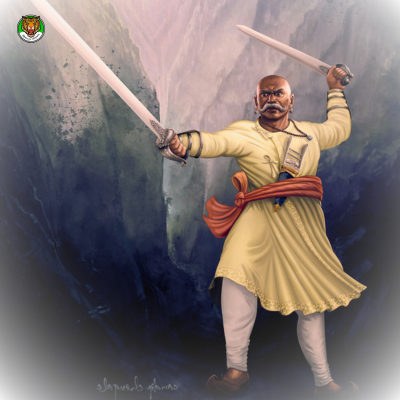Baji Prabhu Deshpande, one of the most valiant and brave Maratha warriors ever, lost his life in the service of his Raja, Chhatrapati Shivaji Maharaj, on July 14, 1660.
The ‘Battle of Pavankhind’, a key rearguard engagement that made it possible for Chhatrapati Shivaji Maharaj to flee the Panhala fort, is linked to the legend of Baji Prabhu Deshpande. But Deshpande paid the ultimate price and gained martyrdom by assisting his king in escaping.
The Backdrop
The battle of Pavankhind, a rearguard pitched battle, took place on July 13, 1660, at a mountain pass named Ghodkhind (An alley between the hills for the horses to pass) near Vishalgadh Fort, close to present-day Kolhapur. The Marathas and the Adilshahi Sultanate engaged in combat. Masood was in charge of the Adilshahi Sultanate’s army, while the terrifying Baji Prabhu Deshpande led the 300 Marathas.
Chhatrapati Shivaji Maharaj and his men kept pushing farther into Bijapuri land, buoyed by the victory over Afzal Khan and the subsequent rout of the Bijapuri army at Pratapgad. A few days later, they took control of the Panhala Fort, which is close to Kolhapur and is strategically important. Another Maratha platoon headed towards Bijapur in the meantime under the command of Netaji Palkar.
The oncoming Maratha forces were, however, ferociously repelled by Bijapur, complicating matters for Chhatrapati Shivaji Maharaj and seriously weakening the Maratha ranks. Chhatrapati Shivaji Maharaj and his remaining forces were compelled to retreat to the Panhala fort after losing several of their leaders and soldiers to the assault.
A general from Ethiopia named Siddhi Johar commanded the Bijapur army. He besieged the Panhala fort after learning the location of Shivaji and his men’s retreat. Despite his persistent attempts, Netaji Palkar was unable to end the siege from the outside.
A bold strategy to break the siege and Heroics of Shiva Kashid
A very ambitious and high-risk strategy was conceived and put into motion once it became clear that they would have to fend for themselves and that outside assistance was unlikely to arrive anytime soon. The plan was for Shivaji, Baji Prabhu Deshpande, and a small group of soldiers to try to break free of the siege in the middle of the night and flee for Vishalgad.
The crucial element of the strategy involved tricking the Bijapur army into not pursuing Shivaji once he had ended the siege. To do this, Shiva Kashid (a barber by profession, but a soldier by heart), a Maratha soldier who bore an astonishing resemblance to Shivaji, offered to masquerade as the king and allow himself to be sacrificed.
A group of 600 carefully chosen warriors, led by the Maratha commander Baji Prabhu and Chhatrapati Shivaji Maharaj, broke the siege on the night of Guru Purnima. They were hotly chased by the Bijapuri soldiers, as one might expect. As planned, Shiva Kashid consented to be apprehended and brought back to the Bijapuri camp. The Maratha forces on the run had some time to get away thanks to this ruse.
However, as soon as the Bijapuri soldiers understood they had captured a Shivaji impersonator rather than a genuine Chhatrapati, they resumed their pursuit of the Maratha forces, which were commanded by Siddhi Masood, Siddhi Johar’s son-in-law. At Ghodkhind, the Marathas launched their last attack. While Baji Prabhu, his brother Phulaji, and the group of 300 troops held their ground to obstruct the advancing Bijapur army, Shivaji and the other 300 Maratha forces advanced towards Vishalgadh.
The Supreme Sacrifice – Making the Ghodkhind ‘Paawan’
The incredible bravery and chivalry exhibited by Maratha warriors during the rearguard action are described in several historical accounts, legends, and folktales. At Ghodkind, Baji Prabhu and his soldiers bravely resisted the numerically superior Bijapuri army for more than 18 hours.
The Maratha army faced overwhelming odds. Baji and his soldiers were severely outnumbered by the ferocious Bijapuri army that was baying for their blood, nearly outnumbered with a ratio of 1:50. The Bijapur army attacked Baji’s forces unrelentingly in their pursuit of capturing Chhatrapati Shivaji Maharaj. However, Baji Prabhu acted as a shield, deterring the enemy troops’ terrible attack. Baji used his body as a barrier to stop the Bijapur warriors from breaking through the defence by swinging extremely large swords (known as Daandpatta) in each hand and slashing them mercilessly at them.
And for this unfathomable daredevilry, he paid a high price. According to several versions, Baji Prabhu was severely hurt, yet he summoned his iron will and displayed an unbreakable fighting spirit, engaging the enemy soldiers continually until the three cannon volleys fired to herald Shivaji’s safe arrival at Vishalgadh. However, in the renowned conflict, Prabhu perished towards the gates of heaven and made a supreme sacrifice.
It is important to note that Shivaji’s genius escape with 300 soldiers to Vishalgad wasn’t an easy one. Bijapur sardars Suryarao Surve and Jaswantrao Dalvi had already begun to attack the fort. To get to the fort, Shivaji Maharaj and his 300 men had to overcome them.
In Maratha history, Baji Prabhu Deshpande holds a significant place. He gave his life for his king to be secure and to carry on the battle against the roving Islamic armies that had taken over much of central India. Deshpande resisted the Bijapuri soldiers with unwavering courage and resolve, buying time for his men to enter the fort after fleeing the enemy siege at Panhala Fort. Shivaji Maharaj later changed the name of the Ghodkhind to Paawan Khind (“Holy Pass”) in recognition of the sacrifice made by Baji Prabhu and his soldiers.
